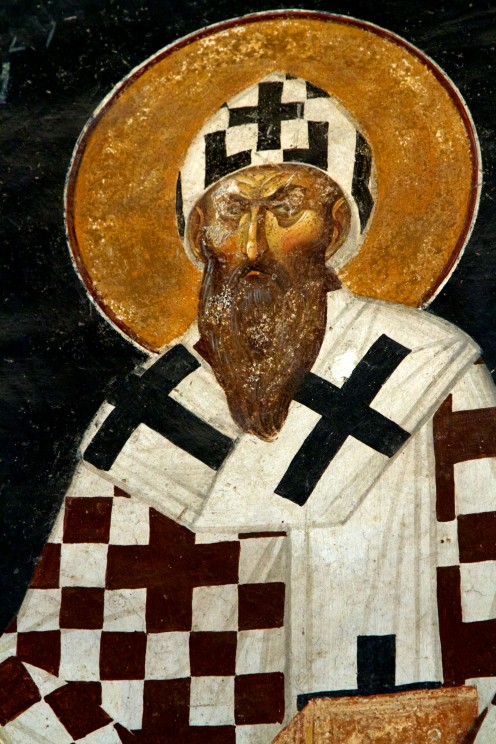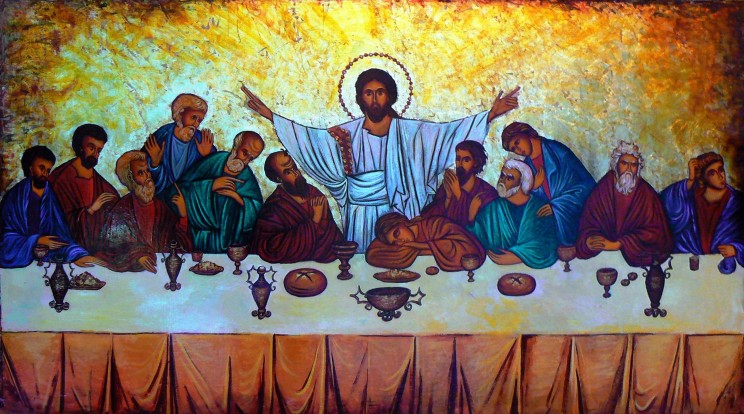Today is Easter Sunday for the majority of the world’s 2.4 billion Christians (most Orthodox Christians will wait until May 1st to celebrate the resurrection of Jesus). After the long penitential season of Lent, Christians are greeting each other with joyful exclamations of “He is risen,” and hearing in glad response, “He is risen indeed, hallelujah!”
The post The God-man resurrected: a philosophical problem for the Incarnation appeared first on OUPblog.
Death. Grief. Sorrow. Those aren’t words that any of us like, especially when they involve those closest to us. I don’t pretend to understand sorrow, though I have experienced it many times. I experienced it when my grandparents died. I experienced it when my own father was in a car accident, and again when my…
It is a well known fact that the Christian church has, in the course of its 2,000-year long history, often been torn with controversy over how to understand those four simple words, ‘This is my body.’
The Orthodox have never been entirely comfortable with the label ‘transubstantiation,’ and at the outset of the Reformation, the Catholic understanding of the Mass was one of the prime issues that provoked Luther to decry the ‘Babylonian captivity’ of the church.
Luther, of course, went on to denounce Zwingli’s view of the Eucharist as vehemently has he had the Catholic one, and slightly later the Reformed followers of Calvin decided that they disagreed with both Luther and Zwingli. The intensity of these debates is understandable in light of the fact that all involved assumed that a correct understanding of the Eucharist had a direct bearing upon the manner in which Jesus was present to his followers.
Was Jesus still here, bringing salvation to his church, or had he departed and left them to get by as well as they could on their own? Defining the nature of this ritual was intrinsically tied to understanding the purpose of this community. Although this story is one often told, the parallels it presents to Christian views on the Bible have often gone overlooked. For the sources of Christian communal identity for the past two millennia include not only a ritual meal but also a written book.
At first this assertion strikes the reader as so obvious it hardly merits mentioning. However, recognizing the importance of this principle accounts for some of the disconnect modern readers of the Bible experience when they attempt to read accounts of scriptural interpretation from late antiquity.
As recounted in Michael Legaspi’s The Death of Scripture and the Rise of Biblical Studies, in the past five hundred years the Bible in the West has undergone a transformation as it was abstracted from its previous home in a unified Christian church and resituated in the context of modern academia.
Such a move would have appeared quite foreign to Christians of an earlier age who assumed that the Bible could not be understood properly apart from grasping its place in the divine plan of salvation centered upon the person of Jesus Christ.
For example, Cyril of Alexandria, the fifth-century bishop of the city that served as the intellectual capital of the Roman world, liked to use a metaphor to explain the Bible’s purpose to his Christian hearers.
In his sermons and writings, he explained the presence of the Bible in the church by stating that Jesus had given this book to his followers, like a shepherd providing his flock with green grass for their nourishment.
Cyril, of course, knew that the Bible was written by countless persons over a vast span of time, and he tried, using the best tools available to him, to attend to that sort of historical detail. But what was most important, in his view, was the fact that when the Bible was read, Jesus himself was present to save, in a manner akin to his presence in the Eucharist.
Whether it was the words of Moses or of the evangelist Mark, when Christians sitting in the basilica in late antique Alexandria heard the scriptures, what they experienced was Jesus himself speaking to them through that myriad of human voices.
And in making this assumption they were following a trajectory already begun in the New Testament itself. Had not the Apostle Paul declared that Christ was speaking in him (2 Cor. 13.3), and did not Jesus himself say that his words were ‘Spirit and life’ (John 6.63)?
For most twentieth-century historians, early Christian exegesis was regarded as unworthy of historical attention due to its failure to attain the standards of modern hermeneutical method.
Imagine the absurd parallel of modern scientists rejecting medieval views on the Eucharist on the basis that those benighted premoderns did not properly understand the chemical composition of bread and wine. Such a dismissal hardly grapples seriously with the way Christians tried to articulate the function of the ritual.
Late antique readers fair somewhat better when seen in their own context. If the Bible is viewed as the written and living voice of Jesus, then the task of interpretation comes to mirror this assumption.
Just as Jesus speaks through the human authors of the Bible, so interpretation must be a process of finding Jesus in those same words, so as to provide spiritual nourishment for Christians seeking to grow in virtue and understanding.
In this way, what Cyril and his contemporaries believed about the Bible determined the way in which they read the Bible as a community, and the consistency of their approach is laudable.
The Bible is open to a great many interpretive approaches, and the plausibility of those methods will always be a product of the community in which the reader is situated. Late antique Christians, who assumed that scripture functioned analogously to the Eucharist, at least managed to find an interpretive method that accorded with their communal experience of this book.
The post ‘This is my word’: Jesus, the Eucharist, and the Bible appeared first on OUPblog.

Image, branding, and logos are obsessions of our age. Iconic images dominate the media. In his new book, Christ to Coke, art historian Professor Martin Kemp examines eleven mega-famous examples of icons, including the American flag, the image of Christ's face, the double helix of DNA, and the heart.

A few weeks ago, we were joined by two wonderful new publicity assistants, Nick and Bobby. Now that they’re settled in, I decided it was time to harass properly introduce them to you. Hopefully this (incredibly interesting) Q&A will show how lucky we are to have them on board.
Do you speak (or pretend to speak) any other languages?
Nick: Yes, Farsi. My parents were born and raised in Iran. They came to the US to continue their studies at college. They met here in the States and a few years later I entered the picture. My first language was, in fact, Farsi. I grew up in a house where my parents and grandparents both spoke to me in Farsi. I did not learn English until I was in early elementary school. Looking back, this now explains so much…
Bobby: I studied Spanish up until sophomore year of college, but I can’t really call what I do with the language “speaking” it. I also studied some Japanese when I studied abroad, and I can now ask where the train station is, I think.
What is your favorite book that was not originally published in English?
Nick: War and Peace. I read it for the first time a few years back after my brother continuously insisted on my commitment to finishing the behemoth of a book. Finally, I gave in and I am now forever indebted to him. This book is my bible and is undoubtedly this best piece of literature ever created. It is both a beautiful story as well as a deep philosophical piece that proves to be a perpetually modern novel that will never lose its relevance in society. This is the only intellectual answer I will provide, promise.
Bobby: Labyrinths by Borges, which might not count since it’s a collection of short stories. No other author has inspired so many moments of disturbed awe and wonder for me. I like when a book freaks me out enough that I have to leave the room.
Fill in the blank: Don’t stop _____________.
a) believing
b) ’til you get enough
c) the music
Nick: ’til you get enough.
Bobby: Believing, duh.
What’s your favorite viral video?
Nick: Does Michael Jackson’s “Thriller” video count?
Bobby: Stalking cat.
Which is more awesome: a Jesus Christ lizard, or a
0 Comments on Meet the New Assistants! as of 1/1/1900










That Walmart comment. It happened to me last night at my parent’s house. I stepped outside to take garbage to a compost pile and thanked God for the privilege. And the tears came. I won’t get to do that task forever. My mom is gone. My father will go. The house will be sold. I want to treasure every moment in that place. The vacuuming of floors, changing of beds, cleaning commodes. And especially the chance to care for my father.
This has been a year of grief for me. Somehow I hadn’t expected to have more sorrows with age although I guess it makes perfect sense. Thanks for sharing your heart. I am sorry for your losses, too Donna.
Beautifully said sweetheart.
Donna, my thoughts and prayers go out to you and your family. I lost my Godfather in January and I am losing my father through mental illness. I completely get the crying for no reason. I have done a lot of that in my car lately. It is so comforting to know that no matter how tear streaked I may look or how angry I may be at a situation, God is still willing to hold me-even if I don’t feel it at that moment. Thank you for this moving post.
Lovely post. The first anniversary of my father’s death is looming and I have been thinking a lot about grief. Thank you for this great way to think about the process.
Grief has a life of it’s own. that’s what I learned after my first husband died over 30 years ago. ANd subsequent griefs can rip open that wound– unexpectedly. But as Joyce said, being raw to grief also can help us treasure the present. Because we never know when we might lose it. I am sorry for your losses; but understand your grief. But even better–the Lord, who has experienced ALL our pain and sorrow–understands it.
Thank you… and AMEN!
It is so hard, all those ‘firsts” after those we love are gone. I am praying for you. And if you need to talk – you know where I am. :)
Thank you for sharing, Kathleen. Losing someone to mental illness is a hard, hard sorrow to bear. I’m so sorry. I’m praying!
I love you. :)
*Hugging you* I’m so glad you have these moments right now, and the ability to take care of your daddy. And thank you for sharing your heart. I am praying for you, my friend.